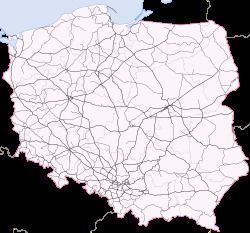Dates of operation 22 May 1842–present | Electrification 3 kV DC Overhead line | |
 | ||
Track gauge 1,435 mm (4 ft 8 ⁄2 in) standard gauge Length 19,599 km (12,178.3 mi) | ||
The Polish railways network consists of around 19,599 kilometres (12,178 mi) of track as of 2008, of which the vast majority is electrified at 3 kV DC overhead.
Contents
- Overview
- Links with adjacent countries
- Broad gauge railways
- PKP Group
- Non PKP Operators
- Rapid transit
- Freight Operators
- References
Poland is a member of the International Union of Railways (UIC): its UIC Country Code is 51.
Rail services are operated by a range of public and private rail operators. The nationally owned PKP Group operates the majority of rail services. In addition to PKP owned companies, there are a number of private cargo operators, as well as a number of independent passenger operators, owned predominantly by Voivodeship governments.
Overview
The network is generally electrified, and the vast majority was built before World War II by different rail companies when territory was part of other countries, including the Deutsche Reichsbahn and Russian Imperial State Railways or by the Communist authorities from 1946 onwards. Due to the average age of the network and lack of maintenance, many sections are limited to speeds below 160 km/h (99 mph) even on trunk lines. 2,568 km (1,596 mi) allow 160 km/h (99 mph) or more.
Since Poland's entry into the European Union in 2004, major financing has been made available by European financing institutions to improve both the Polish rail network and the rolling stock fleet. Up to June 2014, the European Investment Bank had provided loans totaling €1.9 billion for rail modernization projects in Poland. An additional €578 million had been provided through December 2013 to modernize 70 percent of PKP Intercity rolling stock. The €665 million purchase of twenty Alstom Pendolino high speed trains delivered in 2014 was financed in part by €342 million from the European Investment Bank.
Poland currently has no high-speed lines operated at speeds above 200 km/h (124 mph). The Central Rail Line, centralna magistrala kolejowa, 'CMK', which links Warsaw to Katowice and Kraków, was designed with an alignment to permit 250 km/h (155 mph), but for over 30 years after its construction Poland possessed no rolling stock capable of speeds above 160 km/h (99 mph). Since 2008 the CMK has been upgraded to allow higher speeds, including installation of European Train Control System Level 1 which provides the Cab signalling required by high speed trains. Most trains on the CMK still operate at speeds up to 160 km/h (99 mph), but since 14 December 2014 new Alstom Pendolino ED250 trains operate on a 90 km section of the CMK at 200 km/h (124 mph), and improvements under way should raise the authorized speed to 200 km/h (124 mph) on most of the line. In test runs on the CMK in November 2013 a new Pendolino ED250 train set a new Polish speed record of 293 km/h (182 mph).
In 2011-2015 the Warsaw-Gdańsk-Gdynia railway route has undergone a major upgrading costing $3 billion, partly funded by the European Investment Bank, including track replacement, realignment of curves and relocation of sections of track to allow speeds up to 200 km/h (124 mph), modernization of stations, and installation of the most modern ETCS Level 2 signalling system, which is to be completed in June 2015. In December 2014 new Alstom Pendolino high-speed trains were put into service between Gdańsk, Warsaw and Kraków reducing the rail travel time from Gdańsk to Warsaw to 2 hours 58 minutes, to be reduced in late 2015 to 2 hours 37 minutes.
In 2008, the government announced the construction of a dedicated high speed line based on the French TGV model and possibly using TGV style trainsets, by 2020. The Y-shaped line would link Warsaw to Łódź, Poznań and Wrocław at speeds of up to 320 km/h (199 mph)}. The plans included an upgrade of the Central Rail Line to 250 km/h (155 mph) or more, as this line has an LGV-like profile. In December 2011 plans to build the high speed 'Y' line were postponed until 2030, due to the high cost.
As of 2008, foreign services include EuroCity and EuroNight trains between Western and Eastern Europe, most notably the EN Jan Kiepura direct sleeping cars between Russia and Amsterdam, Basel and Munich via Warsaw, Poznan and Germany. They generally consist of coaches from different rail operators that are added to the train as it passes through their area of operation.
Links with adjacent countries
Voltage of electrification systems may differ.
Broad-gauge railways
The network is standard gauge except for the Broad Gauge Metallurgy Line (known by its Polish abbreviation LHS) and a few short stretches near border crossings. The LHS to Sławków is the longest line, single track for almost 400 km from the Ukrainian border just east of Hrubieszów. It is the westernmost broad gauge line connected to the system of the former Soviet Union.
PKP Group
Polskie Koleje Państwowe (PKP), a state-owned corporate group, is the main provider of railway services, holding an almost complete monopoly on long-distance passenger services. It is both supported and partly funded by the government.
Regional trains, categories: Regio, InterRegio, RegioExpress, InterRegioBus.
Non-PKP Operators
While PKP is the largest rail operator in Poland, there are several independent operators of passenger and cargo railway services. Independent Cargo operators are predominantly privately owned. Passenger operators are predominantly owned by Voivodeship governments. These include:
Rapid transit
This includes:
Freight Operators
Freight services are provided by a number of private and public rail operators. These include:
